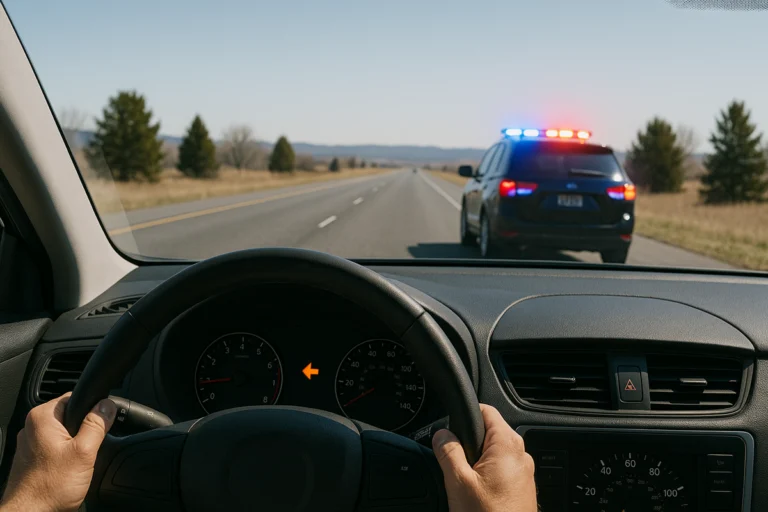Picture this: You’re stranded on the shoulder, hazard lights flashing, and cars are flying past so fast you can feel the air shift. It’s a heart-pounding moment, and one that’s more common than you might think. That’s exactly why Colorado strengthened its Move Over Law in 2023. As drivers, we share a responsibility to protect not just emergency crews but anyone stopped on the roadside. Understanding this law isn’t just about avoiding a ticket , it’s about practicing real defensive driving that could save a life.
Quick Answer: What is Colorado’s Move Over Law?
Colorado’s Move Over Law requires you to move over a lane, or slow down by at least 20 mph, when approaching any stopped vehicle with flashing lights. It applies to all vehicles, not just emergency responders, and violations come with serious penalties.
Full Breakdown: How the Law Works
Here’s the nuts and bolts of Colorado’s Move Over Law:
- On highways: If you see a vehicle stopped on the side, whether it’s a police cruiser or a family minivan, move over one full lane if you can safely do so. If traffic or conditions make that impossible, you must slow down by at least 20 mph below the posted speed limit.
- On roads with lower speed limits:
- If you’re driving in a 40 mph zone or less, slow down to 25 mph or lower when you pass a stopped vehicle.
- If you’re in a 45 mph or higher zone, again, slow by at least 20 mph.
- Flashing hazard lights are your cue to react.
At its heart, this law is about sharing the road and respecting those facing roadside emergencies. It’s a small shift in your routine that could make the difference between a close call and a tragedy.
Why Was the Law Expanded in 2023?
We’ve all seen the flashing lights up ahead, sometimes it’s a fire truck, sometimes it’s just a stranded driver changing a flat in the rain. For years, Colorado’s Move Over Law only protected emergency vehicles. But the dangers don’t discriminate.
In 2023, after a rising number of roadside deaths, Colorado lawmakers expanded the law through HB23-1123. Now, any vehicle stopped with flashing lights deserves your attention and caution. It’s a change built on real heartbreak, because no one should lose their life while trying to fix a tire, fuel up after running out of gas, or help someone else in need.
Who Needs Protection? It’s More Than First Responders
When most people hear “Move Over Law,” they think flashing red and blue lights. But the truth is, the law now protects everyone stuck roadside.
That includes tow truck operators hooking up a disabled car, utility workers fixing downed lines, construction crews managing traffic, and everyday drivers who’ve run into trouble, like a dead battery or hydroplaning into a ditch during a storm.
If someone’s pulled over and their hazards are on, they’re counting on you to give them a fighting chance at staying safe.
Penalties for Violating the Move Over Law
Not moving over or slowing down isn’t just risky, it’s a serious offense under Colorado law.
Violations are treated as a Class 2 misdemeanor traffic infraction, which means a minimum $150 fine and three points tacked onto your license. If someone gets hurt because a driver ignored the law, penalties can escalate to criminal charges, heavier fines, or even jail time.
And beyond the courtroom, there’s the everyday cost: higher insurance rates, possible license suspension, and a whole lot of regret no one wants to live with.
Practical Tips: How to Safely Move Over or Slow Down
Making safe moves around stopped vehicles isn’t just about following the law, it’s about smart, defensive driving that keeps everyone out of harm’s way. Here’s what we recommend:
- Scan ahead: Look beyond the car in front of you so you spot hazards early.
- Check mirrors often: If you need to move over, knowing your surroundings gives you options.
- Signal early and clearly: Give other drivers time to adjust.
- Slow steadily: If you can’t move over, start reducing your speed early, don’t wait until you’re on top of the hazard.
- Stay patient: Lane changes might not be instant, especially in heavy traffic. That’s okay.
Whether it’s a stranded driver or a construction crew ahead, a little more patience and planning goes a long way toward safe roads for all of us.
“Move Over” Laws in Other States – How Colorado Compares
Every state in the U.S. has a Move Over Law, but not all laws are created equal.
In some states, like Kansas and Mississippi, the rules only apply to emergency vehicles. That leaves tow truck drivers, stranded motorists, and utility workers with less protection.
Colorado stands out because our law covers any vehicle with flashing lights. It’s one of the broadest, and strictest, Move Over Laws in the country.
For all of us who drive these roads every day, that’s something to be proud of. It shows that here in Colorado, we take protecting each other’s right of way seriously.
Final Thoughts on Colorado’s Move Over Law: Protecting Lives Starts With You
Moving over isn’t a hassle, it’s a habit worth building. Every time you give someone space or ease off the gas, you’re choosing safety over speed. Let’s make Colorado’s roads safer, one smart move at a time. Defensive driving starts with small decisions like this.
If you’re living in Greeley, Alamosa, or Salida, give us a call to schedule driving lessons that will help you follow this law and others.
